Canoe
Packs
|
Canoe
Packs
|
The ideal pack for a canoe trip should work well when you're on the portage trails, on the water or in camp. Here are some canoe pack features that were on my mind when I designed these packs:
Unloading or loading at a rough
portage landing or when crossing a beaver dam
When you're standing on a rocky shore, trying to hold
on to your canoe and get it unloaded, you want a pack that has a handle and a
pack that doesn't
weight more than forty pounds. You want to grab it with one hand and swing
it onto the shore or to the top of that beaver dam. You want a pack that's
smooth without buckles that can catch on the gunnels or yoke.
On the portage trail
When you're on the portage trail, you want a pack
that's as big as it can be. You want all of your stuff to be in the pack
so you don't drop or lose anything on the trail. Portage trails are cut as
wide as a canoe, so your pack can be that wide too. Your pack should be on
your back so that you can see your feet at all times.
In the canoe on a windy day
When you're in the canoe, you want a pack that sits on
the bottom so that your center of gravity is low. You want packs that
don't go any higher than the gunnels, packs that don't catch the wind and slow
you down. You want packs that shed the rain best when they're in the
canoe, with a top like a tent and a bottom like a bathtub. When your packs
are in the canoe, you'd still like to get at your gear now and then.
In camp
You'd like a pack that's easy to open and close, that keeps it's shape when it's
empty. You'd like a pack that when you open it, you can see all of your
stuff without digging to the bottom or taking things out that you don't need.
In the evening, you'd like a pack that fits easily under your overturned canoe.
The packs described below are are my fifth design, and work well enough so that there probably won't be another.
Click on a picture to enlarge. If it doesn't work, turn off your pop-up blocker
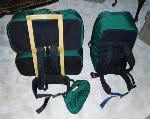 |
 |
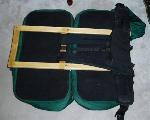 |
 |
 |
 |
 |
 |
 |
 |
 |
 |
 |
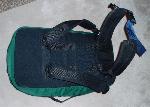 |
 |
 |
 |
 |
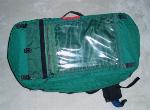 |
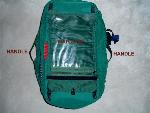 |
 |
 |
 |
 |
 |
 |
 |
These packs have the following features:
Each pack has an internal capacity of about 3,500 cubic inches. When full, a pack almost always weighs less than 40 pounds and can be lifted with one hand.
Two packs attach to the pack frame in about 20 seconds, making a single 80 pound pack.
A separate single pack with an internal frame and attached straps and belt can be worn by the person that carries the canoe.
All packs have a zipper top that opens like a cooler, allowing access to all of the contents, even when you're in the canoe on the water.
All packs have a "lid" that sheds rain and a bathtub design that resists water intrusion from the bottom.
Each pack has an internal liner with zippers. Closed cell foam panels keep the packs in shape, even when empty, and provide increased water resistance.
Each pack has a handle - it can easily be lifted with one hand and tossed onto shore or over obstacles.
Three packs fit exactly into a tandem canoe. They cannot shift or roll when the canoe rolls and they do not extend above the gunnels.
A small bag (for camera, tackle and water) attaches to clips on the gunnel when in the canoe and to either belt when on the portage trail.
I've found that with these packs my son and I can single portage our 50 pound canoe.